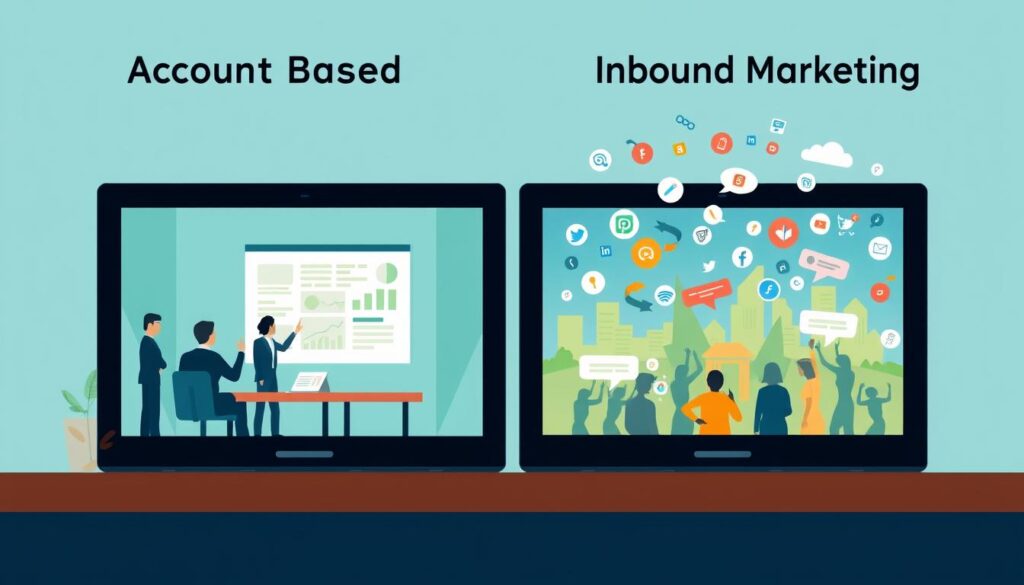Did you know 87% of B2B marketers use account-based marketing (ABM) strategies? This shows ABM’s growing importance in marketing. But how does it differ from inbound marketing? Let’s look at the main differences and how they can work together for success.
Key Takeaways
- Account-based marketing (ABM) focuses on customized experiences for individual high-value accounts, while inbound marketing casts a broader net to attract a wider audience.
- ABM relies on personalized communication and collaboration between sales and marketing, whereas inbound marketing often operates with less input from sales teams.
- Metrics for success differ, with ABM emphasizing engagement, click-through rates, and open rates, while inbound marketing tracks conversions, leads, and revenue.
- Combining ABM and inbound marketing can create a powerful hybrid strategy, leveraging the strengths of both approaches.
- The choice between ABM and inbound marketing depends on factors like customer base, product offerings, and growth goals.
The main difference between account-based marketing and inbound marketing is their targeting. Inbound marketing aims to attract a wide audience with valuable content. ABM, on the other hand, targets specific high-value accounts with personalized experiences.
Inbound marketing focuses on getting many leads, while ABM values quality over quantity. It targets a few accounts that match the ideal customer profile. This approach helps build strong, valuable relationships with key prospects.
By understanding the strengths of both ABM and inbound marketing, marketers can create a hybrid strategy. This integrated approach can speed up sales cycles, boost customer loyalty, and drive growth.
What is Account-Based Marketing?
Account-based marketing (ABM) is a focused strategy for B2B marketing and sales. It targets high-value accounts, unlike broad audiences. The aim is to offer personalized experiences for each account, boosting impact and return on investment.
Defining Account-Based Marketing (ABM)
ABM treats each account as its own market. It’s a b2b marketing strategy that doesn’t use a one-size-fits-all approach. Instead, it tailors efforts to each account’s unique needs and challenges.
This key account strategy leads to more personalized account engagement. It builds stronger relationships and improves results.
By focusing on high-potential accounts, companies can manage their resources better. An account-centric sales approach and strategic account management ensure a consistent, personalized buying experience. This keeps customers engaged and happy.
Recent studies show that 92% of companies with mature ABM programs see more ROI than other marketing tactics. Also, 71% of consumers expect personalized interactions, and 76% get frustrated when they don’t get it. Personalized account based marketing strategies increase relevance and engagement with high-value accounts. This leads to better customer acquisition and retention.
How Account-Based Marketing Works
Account-based marketing (ABM) treats each high-value account as its own market. It’s different from traditional lead-based marketing. ABM focuses on account-focused campaigns and personalized experiences for key decision-makers. This approach helps sales and marketing work together better, leading to faster growth.
ABM’s core is giving a tailored experience to high-value accounts. Companies treat each account as its own market. This way, they can create campaigns that meet the specific needs of their stakeholders. This approach delights the accounts and boosts the chance of getting valuable business.
ABM can be one-to-one, one-to-few, or one-to-many. The best companies mix these approaches to get the most out of their marketing.
| ABM Approach | Description |
|---|---|
| One-to-One | Highly customized marketing programs for individual accounts |
| One-to-Few | Focused on groups of 5-15 accounts with similar business issues |
| One-to-Many | Addresses a strategically curated target account list of several hundred or more named accounts |
The success of ABM depends on sales and marketing working together. It also needs the right technology and a focus on giving a personalized experience to high-value accounts.

Account Based Marketing vs. Inbound Marketing: Similarities
Common Elements of ABM and Inbound
Inbound marketing and account-based marketing (ABM) share key elements. They both need a deep understanding of your target buyer. This helps in creating the right content and how to deliver it.
Both strategies aim to increase discoverability by your ideal accounts. You can also reuse content and channels for ABM that you’ve already used in inbound marketing. ABM often personalizes this content further for high-value accounts.
Both inbound and ABM focus on a great buying experience. They aim to create targeted, personalized content for your ideal customers. This content addresses their unique pain points and needs at every sales stage.
Inbound marketing attracts a wide range of leads, while ABM targets specific high-value accounts. Combining both strategies offers a comprehensive, targeted approach. This approach drives growth for businesses.
The Benefits of Using ABM and Inbound Together
Inbound marketing helps attract the right customers. Account-based marketing (ABM) speeds up the customer journey. Together, they help you win key accounts and grow your business.
Use account-based marketing with an inbound focus. This means creating content and experiences for your top accounts. Combining ABM and inbound marketing makes your marketing stronger.
- Less than a third of salespeople report that their marketing team is their best source for leads.
- 87% of marketers who use Account-Based Marketing (ABM) believe it outperforms all their other marketing investments.
- Businesses with mature ABM strategies attribute as much as 73% of their total revenue to ABM.
ABM can lead to higher ROI than other marketing in 97% of cases. But, it needs everyone in the organization to agree and work together. It’s best for B2B companies focusing on a few key accounts.
Team alignment is key for ABM. Sales and marketing must work together from the start. ABM also needs personalized content and data management. By combining ABM and inbound marketing, teams can share data and insights better.
When making personas for ABM, each account should have multiple personas. ABM campaigns focus on personalized experiences, not just using someone’s name in an email. An inbound marketing strategy can support ABM by adapting content for each account.
How to Implement Account-Based Marketing
To keep our customers at the center, we must follow key principles in our account-based marketing strategy. Our strategy should focus on customizing how we talk to our target companies. There are five main stages: Identify, Expand, Engage, Advocate, and Measure.
Creating content that blends with both strategies helps us reach more people. This approach boosts brand awareness and leads. It also adds value to our ABM clients who need more convincing.
Research from SiriusDecisions found that 80% of marketers see better win-rates with ABM. ABM targets high-value accounts for the best ROI.
Creating Ideal Customer Profiles (ICP) and Target Account Lists (TAL) is key. This helps us tailor our marketing. ABM channels include direct mail, digital ads, and more.
Using a central platform for ABM is vital for tracking and improving. Companies using ABM see a 171% increase in contract value. 60% of marketing teams report higher revenue after a year.
Aligning our marketing and sales teams boosts our results. 70% of ABM users say their teams are aligned, unlike 51% without ABM. Adopting an account-centric sales approach can change our business.
The Differences Between ABM and Inbound Marketing
Account-based marketing (ABM) and inbound marketing differ mainly in who they aim to reach. Inbound marketing tries to attract a wide range of customers, focusing on high-quality leads. On the other hand, ABM targets specific, high-value customers who match the ideal client profile closely. Both methods aim for personalization, but ABM is more precise, focusing on individual people.
Contrasting ABM and Inbound Approaches
Inbound marketing uses content like blog posts and videos to draw in a large audience. In contrast, an ABM strategy begins by understanding the target audience. It defines the ideal client, identifies companies to target, and then engages with them directly.
| Account-Based Marketing (ABM) | Inbound Marketing |
|---|---|
| Targets specific high-value accounts | Focuses on attracting a wider audience |
| Personalizes campaigns for key decision-makers | Employs content creation and SEO optimization |
| Measures success through leads generated and conversion rates | Measures success through leads generated and ROI |
| Typically used in B2B marketing | Used in both B2B and B2C marketing |
The choice between account based marketing strategies and inbound marketing strategies depends on several factors. These include the business model, target audience, sales cycle, and budget. Some companies find success with a mix of both personalized account engagement and account-focused campaigns, creating a strong account-based experience.

When to Use Account-Based Marketing vs. Inbound Marketing
Businesses face a choice between account-based marketing (ABM) and inbound marketing. The best choice depends on your company size, target audience, and goals.
Large companies with many customers or varied offerings might prefer inbound marketing. On the other hand, smaller businesses or those focused on keeping customers might do better with account-based marketing.
Combining these tactics can be great for improving client relationships and growing leads. Start by understanding your customer base and how to reach them. Then, work together with marketing and sales to create engaging content and messages.
| Inbound Marketing | Account-Based Marketing (ABM) |
|---|---|
| Focuses on attracting a wider audience through valuable content and organic channels | Targets specific high-value accounts with personalized campaigns |
| Aims for a broader customer base | More tailored towards individual accounts |
| Can be beneficial for large companies with diverse offerings | Ideal for smaller, specialized businesses or those focused on customer retention |
The choice between account-based marketing and inbound marketing depends on your goals, audience, and resources. Knowing the strengths of each can help you create a marketing strategy that works best for your business.
Driving Sales with the Right Marketing Process
Choosing between account based marketing strategies and inbound marketing strategies is key for sales. Inbound marketing works well for big companies with lots of customers and products. Account-based marketing (ABM) is better for smaller companies with special offers, as it targets specific customers.
Using both inbound and ABM can be great. It helps drive more business and build strong customer ties. This mix offers the best of both worlds, boosting sales and revenue growth.
| Metric | Inbound Marketing | Account-Based Marketing |
|---|---|---|
| ROI | Higher for larger companies | 84% of businesses using ABM say it delivers higher ROI |
| Ideal Company Size | Larger companies with thousands/millions of customers | Effective for B2B companies selling to a few large key accounts |
| Key Focus | Broad range of products | Highly-specialized custom offers |
| Target Audience | Broader audience | Specific, targeted accounts and decision-makers |
Understanding the strengths of account based marketing strategies and inbound marketing strategies is crucial. Businesses can craft a marketing plan that boosts sales, strengthens customer ties, and offers top-notch account-based experiences. The goal is to find the right mix of these methods to meet your growth goals.
Conclusion
Account-based marketing (ABM) and inbound marketing have their own strengths in B2B sales and marketing. ABM tailors your approach to key accounts, while inbound marketing draws in a wider audience. It guides leads through the sales funnel.
Choosing between ABM and inbound marketing depends on your business goals and resources. ABM can increase deal size and ROI for companies willing to invest in detailed research and tailored content. Inbound marketing is better for businesses aiming to attract more leads and build a steady pipeline.
The best strategy often combines the best of both worlds. By using targeted b2b marketing and personalized account engagement, businesses can achieve growth, loyalty, and success. This balanced approach creates a powerful strategy for long-term success.

